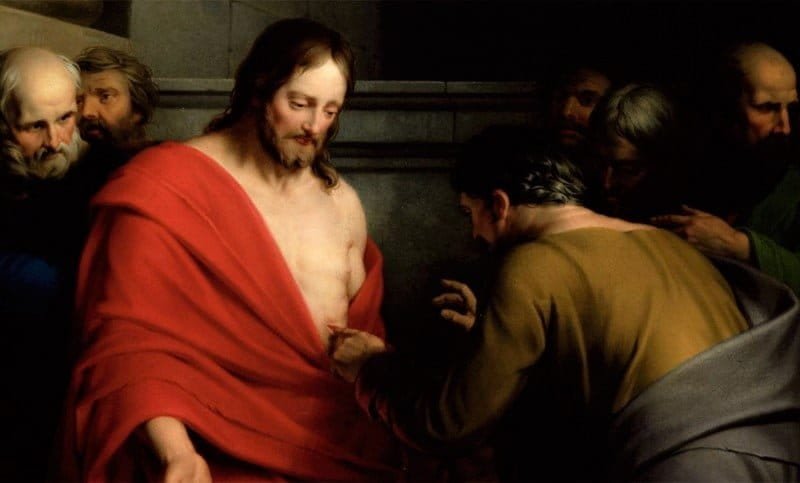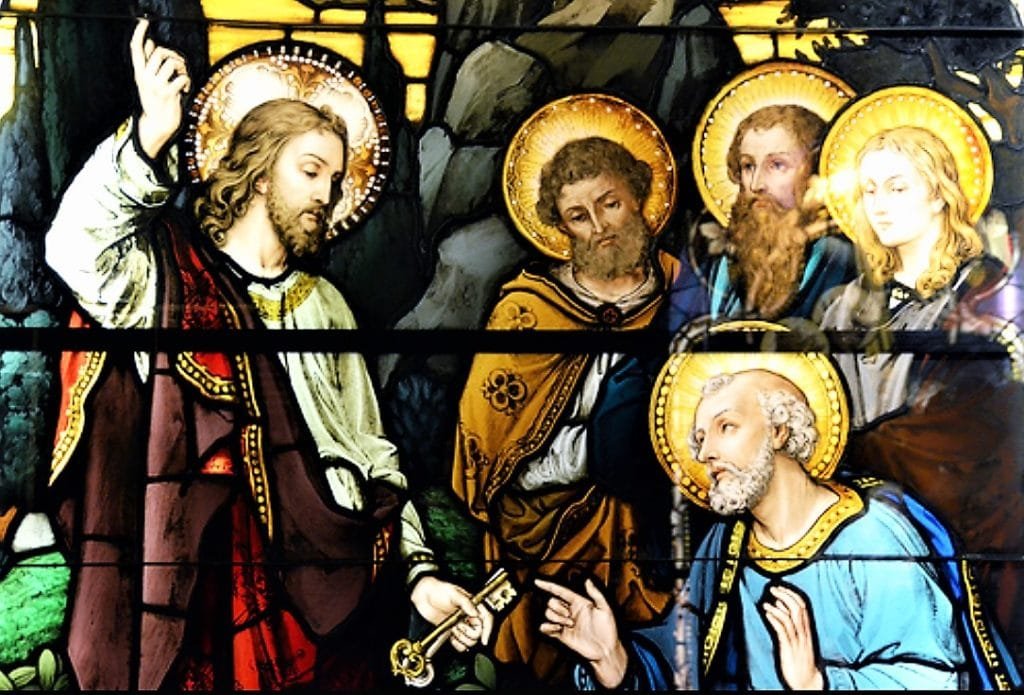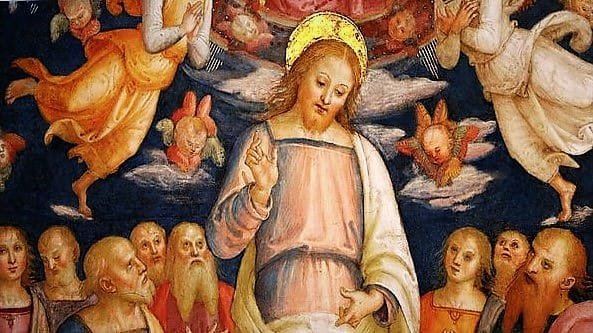POPE FRANCIS REFLECTION ON THE 3RD SUNDAY OF EASTER B.

REGINA CAELI
Saint Peter’s Square
Sunday, 18 April 2021
3rd Sunday of Easter B
Dear Brothers and Sisters, Buongiorno!
On this Third Sunday of Easter, we return to Jerusalem, in the Cenacle, as guided by the two disciples of Emmaus, who had listened with great emotion to Jesus’ words along the way and then had recognized him “in the breaking of the bread” (Lk 24:35). Now, in the Cenacle, the Risen Christ presents himself in the midst of the group of disciples and greets: “Peace to you!” (v. 36). But they are frightened and believe “that they saw a spirit” (v. 37), as the Gospel says. Then Jesus shows them the wounds in his body and says: “See my hands and my feet” – the wounds – “that it is I myself; handle me” (v. 39). And to convince them, he asks for food and eats it before their astonished eyes (cf. vv. 41-42).
There is a detail here, in this description. The Gospel says that the Apostles “they still disbelieved for joy”. The joy they had was such that they could not believe that this was true. And a second detail: they were bewildered, astonished; astonished because the encounter with God always leads you to astonishment: it goes beyond enthusiasm, beyond joy; it is another experience. And they were joyful, but a joy that made them think: no, this cannot be true!... It is the astonishment of God’s presence. Do not forget this frame of mind, which is so beautiful.
Three very concrete verbs characterize this Gospel passage. In a certain sense, they reflect our individual and community life: to look, to touch and to eat. Three actions that can give joy from a true encounter with the living Jesus.
To look. “See my hands and my feet”, Jesus says. To look is not only to see, it is more; it also involves intention, will. For this reason, it is one of the verbs of love. A mother and father look at their child; lovers gaze at each other; a good doctor looks at the patient carefully…. Looking is a first step against indifference, against the temptation to look the other way before the difficulties and sufferings of others. To look. Do I see or look at Jesus?

The second verb is to touch. By inviting the disciples to touch him, to verify that he is not a ghost – touch me! – Jesus indicates to them and to us that the relationship with Him and with our brothers and sisters cannot remain “at a distance”. Christianity does not exist at a distance; Christianity does not exist only at the level of looking. Love requires looking and it also requires closeness; it requires contact, the sharing of life. The Good Samaritan did not limit himself to looking at that man whom he found half dead along the road: he stopped, he bent down, he treated his wounds, he touched him, he loaded him on his mount and took him to the inn. And it is the same with Jesus himself: loving him means entering into a communion of life, a communion with Him.
And thus, we come to the third verb, to eat, which clearly expresses our humanity in its most natural poverty, that is, our need to nourish ourselves in order to live. But eating, when we do so together, among family or friends, also becomes an expression of love, an expression of communion, of celebration…. How often the Gospels present Jesus to us who experiences this convivial dimension! Even as the Risen One, with his disciples. To the point that the Eucharistic Banquet has become the emblematic sign of the Christian community. Eating together the Body of Christ: this is the core of Christian life.
Brothers and sisters, this Gospel passage tells us that Jesus is not a “ghost”, but a living Person; that when Jesus draws near to us he fills us with joy, to the point of disbelief, and he leaves us bewildered, with that astonishment that only God’s presence gives, because Jesus is a living Person.
Being Christian is not first of all a doctrine or a moral ideal; it is a living relationship with Him, with the Risen Lord: we look at him, we touch him, we are nourished by Him and, transformed by his Love, we look at, touch and nourish others as brothers and sisters. May the Virgin Mary help us to live this experience of grace.
SOURCE: https://www.vatican.va/content/francesco/en/angelus/2021/documents/papa-francesco_regina-caeli_20210418.html
EMPHASIS MINE.
SEE AS WELL:
3RD SUNDAY OF EASTER YEAR B MASS PRAYERS AND READINGS HERE.
3RD SUNDAY OF EASTER YEAR B HOMILY REFLECTION HERE , HERE AND HERE.

REGINA CÆLI
Saint Peter’s Square
3rd Sunday of Easter B, 15 April 2018
Dear Brothers and Sisters, Good morning!
At the centre of this Third Sunday of Easter there is the encounter with the Risen One experienced by his disciples, all together. This is evidenced especially by the Gospel which introduces us once again to the Upper Room, where Jesus manifests himself to the Apostles, addressing this greeting to them: “Peace to you” (Lk 24:36). It is the greeting of the Risen Christ, who gives us peace: “Peace to you!”. It is a matter of both inner peace and the peace that is established in interpersonal relationships. The episode recounted by Luke the Evangelist rests heavily on the realism of the Resurrection. Jesus is not a spirit. Indeed, it is not about an apparition of Jesus’ spirit, but of his real presence with his risen body.
Jesus realizes that the Apostles are unsettled in seeing him, that they are bewildered because the reality of the Resurrection is inconceivable to them. They believe they are seeing a spirit; but the Risen Jesus is not a spirit; he is a man with body and soul. This is why, in order to convince them, he says to them: “See my hands and my feet” — he shows them his wounds — “that it is I myself; handle me, and see; for a spirit has not flesh and bones as you see that I have” (v. 39). And since this did not seem enough to overcome the disciples’ disbelief — the Gospel says something interesting: there was so much joy they had within that this joy prevented them from believing it: ‘No, it cannot be! It cannot be so! So much joy is not possible!’. And Jesus, in order to convince them, asks them: “Have you anything here to eat?” (v. 41). They offer him some broiled fish; Jesus takes and eats it in front of them, in order to convince them.
Jesus’ insistence on the reality of his Resurrection illuminates the Christian perspective of the body: the body is not an obstacle nor a prison of the soul. The body is created by God, and mankind is not complete if there is no union of body and soul. Jesus, who has triumphed over death and risen in body and soul, helps us to understand that we must have a positive idea of our body. It can become an occasion or instrument of sin, but sin is not provoked by the body, but rather by our moral weakness. The body is a wondrous gift from God, intended, in union with the soul, to express in fullness the image and likeness of Him. Therefore, we are called to have great respect and care for our body and that of others.
Any offense or wound or violence to the body of our neighbour is an affront to God the Creator! My thoughts go, in particular, to the children, the women, the elderly who are physically abused. In the flesh of these people we find the Body of Christ. Christ wounded, mocked, slandered, humiliated, scourged, crucified…. Jesus taught us love. A love that, in his Resurrection, is demonstrated to be more powerful than sin and death, and seeks to redeem all those who experience in their own body the slavery of our time.
In a world where too often self-importance prevails over the weakest and materialism stifles the spirit, today’s Gospel passage calls us to be people capable of looking deeply, full of wonder and great joy at having encountered the Risen Lord. It calls us to be people who know how to welcome and appreciate the novelty of life that He sows in history, in order to direct it toward new heavens and the new land. May we be sustained in this journey by the Virgin Mary, to whose maternal intercession we entrust ourselves with faith.
SOURCE: https://www.vatican.va/content/francesco/en/angelus/2018/documents/papa-francesco_regina-coeli_20180415.html
EMPHASIS MINE.

REGINA CÆLI
Saint Peter’s Square
Third 3rd Sunday of Easter B, 19 April 2015
Dear Brothers and Sisters, Good morning,
In the Bible Readings of today’s liturgy the word “witnesses” is mentioned twice. The first time it is on the lips of Peter who, after the healing of the paralytic at the Door of the Temple of Jerusalem, exclaims: You “killed the Author of life, whom God raised from the dead. To this we are witnesses” (Acts 3:15). The second time it is on the lips of the Risen Jesus. On the evening of Easter he opens the minds of the disciples to the mystery of his death and Resurrection, saying to them: “You are witnesses to these things” (Lk 24:48). The Apostles, who saw the Risen Christ with their own eyes, could not keep silent about their extraordinary experience. He had shown himself to them so that the truth of his Resurrection would reach everyone by way of their witness. The Church has the duty to continue this mission over time. Every baptized person is called to bear witness, with their life and words, that Jesus is Risen, that Jesus is alive and present among us. We are all called to testify that Jesus is alive.
We may ask ourselves: who is a witness? A witness is a person who has seen, who recalls and tells. See, recall and tell: these are three verbs which describe the identity and mission. A witness is a person who has seen with an objective eye, has seen reality, but not with an indifferent eye; he has seen and has let himself become involved in the event. For this reason, one recalls, not only because she knows how to reconstruct the events exactly but also because those facts spoke to her and she grasped their profound meaning. Then a witness tells, not in a cold and detached way but as one who has allowed himself to be called into question and from that day changed the way of life. A witness is someone who has changed his or her life.
The content of Christian witness is not a theory, it’s not an ideology or a complex system of precepts and prohibitions or a moralist theory, but a message of salvation, a real event, rather a Person: it is the Risen Christ, the living and only Saviour of all. He can be testified to by those who have personal experience of Him, in prayer and in the Church, through a journey that has its foundation in Baptism, its nourishment in the Eucharist, its seal in Confirmation, its continual conversion in Penitence. Thanks to this journey, ever guided by the Word of God, every Christian can become a witness of the Risen Jesus. And his/her witness is all the more credible, the more it shines through a life lived by the Gospel, a joyful, courageous, gentle peaceful, merciful life. Instead, if a Christian gives in to ease, vanity, selfishness, if he or she becomes deaf and blind to the question of “resurrection” of many brothers and sisters, how can he/she communicate the living Jesus, how can the Christian communicate the freeing power of the living Jesus and his infinite tenderness?
May Mary our Mother sustain us by her intercession, that we might become, with all our limitations but by the grace of faith, witnesses of the Risen Lord, bringing the Paschal gifts of joy and peace to the people we encounter.
SOURCE: https://www.vatican.va/content/francesco/en/angelus/2015/documents/papa-francesco_regina-coeli_20150419.html
EMPHASIS MINE.
SEE AS WELL:
REFLECTION HOMILY ON THE THIRD / 3RD SUNDAY OF EASTER YEAR B HERE.
THIRD / 3RD SUNDAY OF EASTER MASS PRAYERS AND READINGS HERE.
Stay updated: subscribe by email for free TO OUR NEW WEBSITE www.catholicsstrivingforholiness.org (PUT YOUR EMAIL IN THE SUBSCRIBE WIDGET).
We are also in www.fb.com/Catholicsstrivingforholiness. Kindly help more people in their Christian life by liking our page and inviting your family, friends and relatives to do so as well. Thanks in advance and God bless you and your loved ones! Fr. Rolly Arjonillo